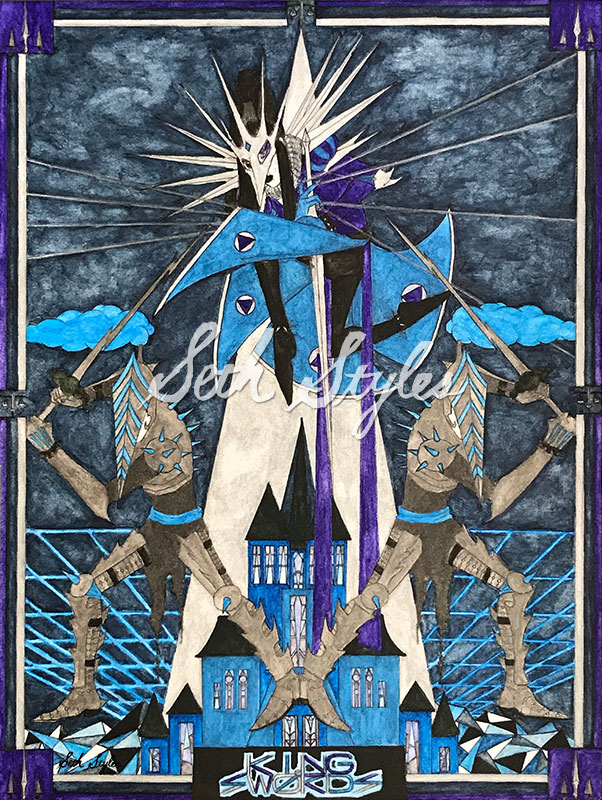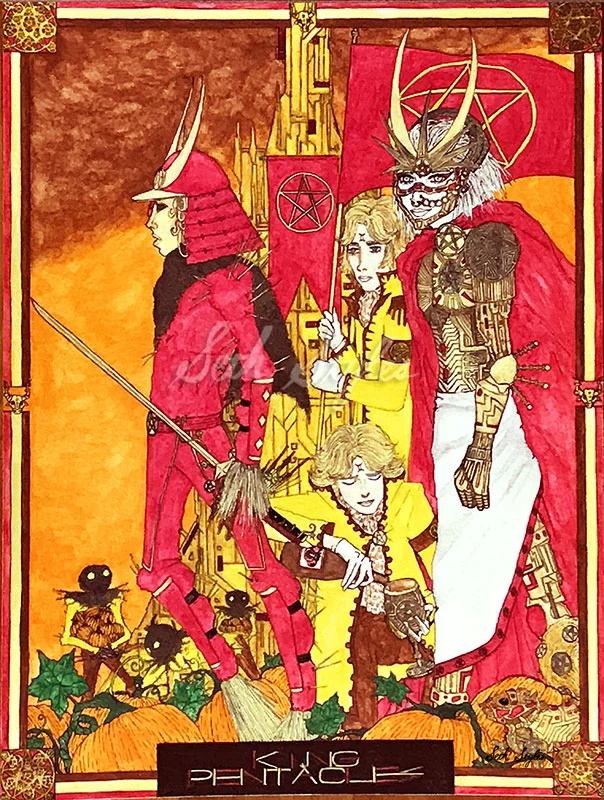Our final frigid stop on our tour through the Kingdom of Swords finds us at the symmetrical castle where the King of Swords resides… if you could call it residing. Here is a figure that found a means to drain himself of the emotions that threatened to distract him from his focus. His eyes have been surgically replaced with scrutinizing metal orbs, his face is constantly hidden behind a mask of honed, precisely sharpened metal, and rumors circulate around the Kingdom of Swords that his heart has even been replaced by more efficient machinery. To the King of Swords, humanity is an unwelcome anchor that restrained him from achieving true perfection.
The Calculated Order of the King of Swords
The King of Swords is a brilliant strategist, dissecting human behavior in constant search of patterns to potentially exploit for his idea of the greatest good. Strings are tied around his fingers, extending to unknown points of importance spanning across the Kingdom of Swords and beyond. These strings feed the King of Swords information that may help him further his plans while allowing him a direct line of manipulation. Though he lives in his own sense of honor, he will mold the world to his own design if necessary, meaning that he has no reservations about manipulating even those closest to him. His full faith and devotion is invested in a concept that is in his mind higher than the workings of humans. A grid of lasers cuts across the dark skies, representing his mathematically exacting control, even over elements of chaos. This focused control is also evidenced by the Sword Knights that flank him in perfect symmetry. Sword Knights are notorious for wildly and blindly stabbing at anything in their confusion (often one another), yet in the vicinity of the King of Swords, they develop an almost supernatural clarity.
Served by Coldness
The King of Swords is an intentionally cold individual because a lack of emotion is the most logical way to reach that which he deems a higher state of being. He keeps his hair pulled back neatly in a top knot style that maintains a regality while allowing him unfettered focus. His robotic eyes aid him in judging situations with unparalleled fairness, though this sometimes coincides with mercilessness. A deep, dark iciness emanates from the King of Swords’ chest as his empathy succumbed to a self-inflicted, psychic frost bite long ago. The people of the Kingdom of Swords celebrate his renowned fairness. Dressed in flowing purple robes, he knowingly wears the color of wisdom and royalty, though metallic blades jut forth from his shoulders, spiked bands line his wrists and ankles, and blades line his skirt, promoting a sense of fear in even those who deeply revere him. This is because he has proven himself to be loyal to ideas over people.
Beyond the Veneer of House Swords
Since the King of Swords has given himself completely to matters of thought while rejecting matters of emotion, he has failed his family on an emotional level. The Queen of Swords spends her free moments locked away in an icy wing of the palace, haunted by past joys that ultimately died. The Page of Swords roams the kingdom, wildly challenging the world around him as a continued reinforcement of his mental superiority. When the family are united, it is in mutual devotion of progress and the furtherance of the House of Swords whether that be political, economical, or otherwise. Does the King of Swords love his family? By his definition, he most likely does. But his idea of love is probably much closer to our idea of emotionless respect or an approval of efficiency.
The border reinforces the King of Swords’ fair yet harsh judgments through a set of scales. The corners show his focus and control represented by a sword flanked by two smaller swords, all facing the same direction.

































